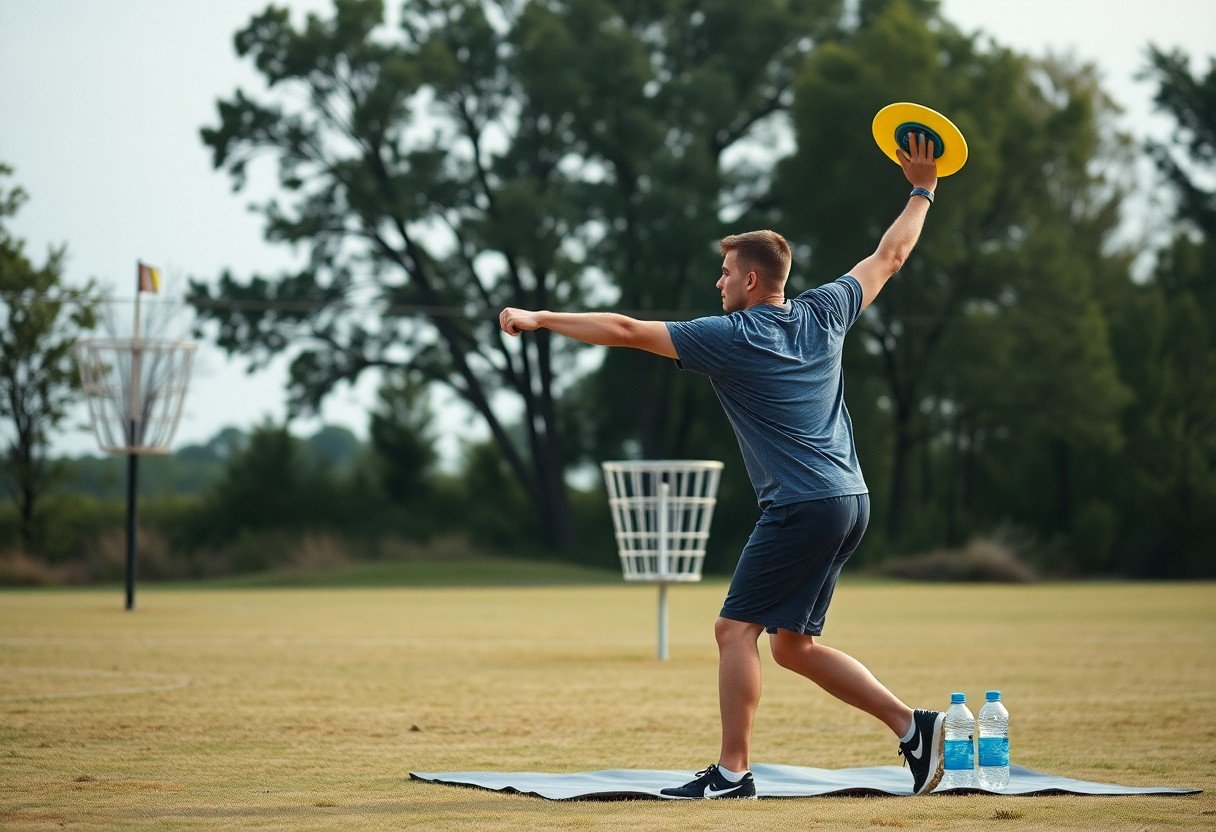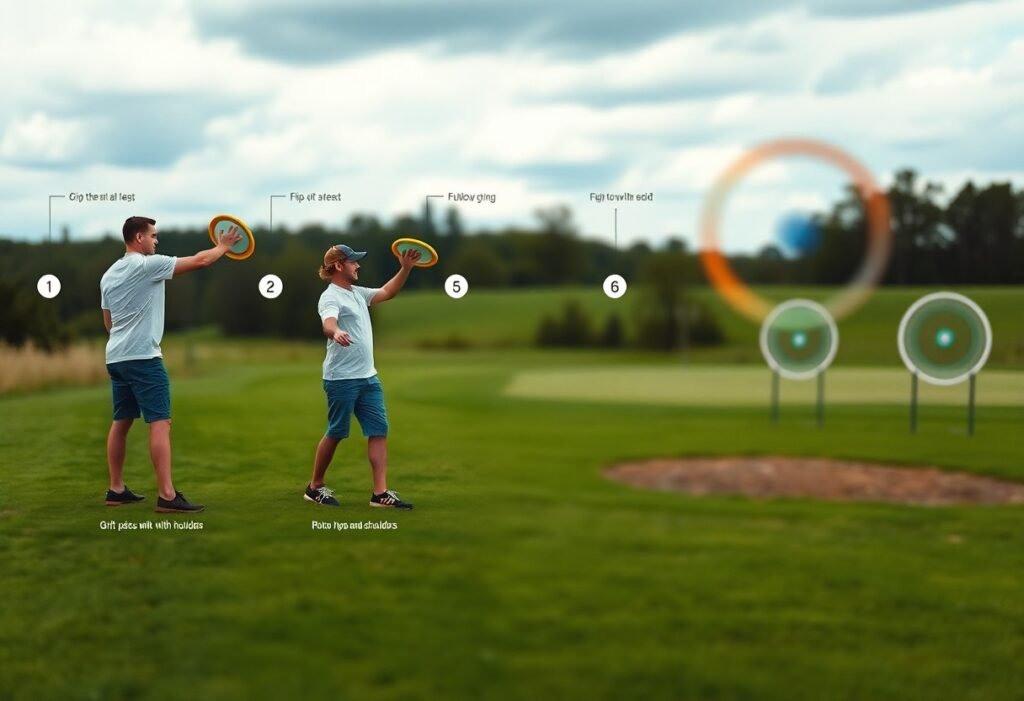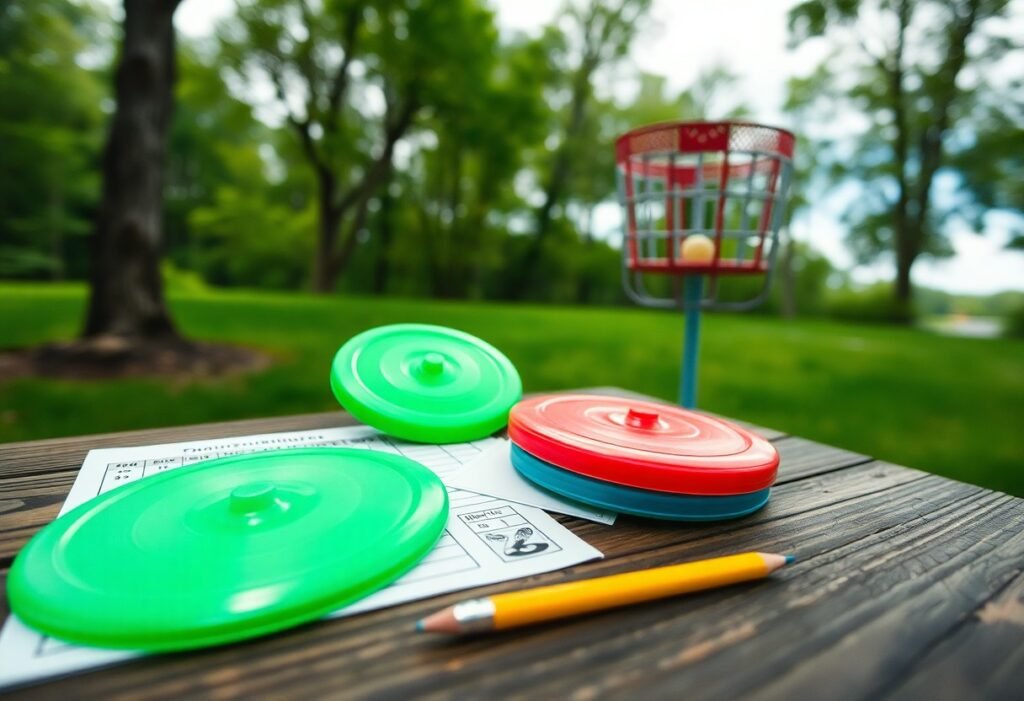Most players underestimate the importance of physical fitness in enhancing their disc golf performance. By incorporating targeted exercises, you can significantly increase your throwing power, leading to longer drives and improved accuracy. Focusing on strength, flexibility, and core stability will not only boost your game but also help prevent injuries. This post will guide you through vital workouts specifically designed to enhance your disc golf skills, ensuring you remain at the top of your game.
Key Takeaways:
- Strength training, focusing on core and lower body, enhances throwing power.
- Flexibility and mobility exercises improve range of motion for better throws.
- Incorporating stability and balance drills can prevent injuries and improve consistency.

Understanding Disc Golf
The Basics of Disc Golf
Disc golf is played on a course consisting of 18 holes, where players aim to throw a disc into a series of metal baskets. Each hole begins with a tee pad, and players take turns throwing their discs toward the basket, with the goal of completing the course in the fewest throws possible. Courses can vary in difficulty, terrain, and environmental challenges, adding to the sport’s complexity and appeal.
Importance of Physical Fitness in Disc Golf
Physical fitness significantly enhances your performance in disc golf. Stronger muscles enable you to generate more power in your throws, while improved endurance allows you to maintain focus throughout long rounds. Flexibility and balance contribute to better form, reducing the risk of injuries while playing.
Being physically fit not only boosts your throwing power but also enhances your overall game strategy. Players with better cardiovascular fitness tend to feel less fatigued, which is vital during tournaments that can last several hours. Additionally, specific strength training can increase your stability during throws, allowing you to develop a consistent form. As a result, investing in your physical fitness can lead to improved scores and greater enjoyment of the sport.

Anatomy of a Strong Throw
Key Muscle Groups Involved
To generate maximum power in your throw, you need to engage several key muscle groups. The primary muscles involved include your shoulders, core, and legs. Your shoulders facilitate the release and follow-through of the disc, while your core stabilizes movement and enhances rotational power. Strong legs provide a stable base, allowing for an effective transfer of energy from your lower body through to your upper body during the throw.
Mechanics of a Successful Throw
The mechanics of a successful throw hinge on a combination of body positioning, arm movement, and follow-through. Start by maintaining a strong stance with your feet shoulder-width apart, which promotes balance. Focus on engaging your hips and core during the throwing motion, as they play a significant role in generating speed and distance.
Effective throwing involves several phases: the wind-up, where you rotate your shoulders and hips to build tension; the pull-through, which should be a swift and controlled motion that uncoils your body; and the follow-through, where your arm continues the momentum, ensuring a smooth release and accuracy. Each phase contributes to the overall power and precision of your throw, so practicing these components in isolation can lead to significant improvements in your performance.
Core Strength and Stability
Importance of Core Strength
Your core is the powerhouse of your body, providing stability and balance during every throw. Strong core muscles help transfer energy from your lower body to your upper body, allowing for increased throwing distance and accuracy. According to studies, a well-conditioned core can enhance your overall performance, making it imperative for any disc golfer looking to level up their game.
Core Exercises for Disc Golf
Incorporating specific core exercises into your training regimen will significantly benefit your disc golf game. Focus on movements like planks, Russian twists, and medicine ball rotations, which engage the entire core while mimicking the rotational forces involved in throwing. These exercises not only build strength but also improve your stability and balance, key factors for executing powerful throws.

Upper Body Strength Training
Muscle Groups Targeted
Focusing on upper body strength training specifically engages your pectorals, deltoids, triceps, and back muscles. These muscle groups play a significant role in the throwing motion, helping you generate explosive power and stability while maintaining control. By strengthening these areas, you enhance your overall performance and reduce the risk of injury.
Effective Exercises
Incorporate exercises like bench presses, shoulder press, pull-ups, and bent-over rows into your routine. These movements not only build strength but also improve your muscular endurance, crucial for those long rounds on the course. Aim for 3–4 sets of 8–12 reps for optimal results.
For instance, the bench press targets your chest and triceps, providing crucial pushing strength. Meanwhile, the shoulder press focuses on your deltoids, enhancing your ability to lift and control the disc during your throw. Pull-ups are excellent for back strength and grip, critical for spin and finishing power. Including these exercises regularly will significantly improve your upper body strength, directly impacting your disc golf performance.
Lower Body Strength and Power
The Role of Legs in Throwing Power
Your legs play a vital role in generating throwing power. The power for your throw starts with your feet, transferring energy through your legs, and into your upper body. A strong lower body improves your stability and balance, allowing for a more explosive and controlled throw. Engaging your glutes, quads, and calves efficiently during your drive significantly enhances your overall distance and accuracy.
Strengthening Exercises
Incorporate exercises that target your lower body strength to improve your disc golf performance. Squats, lunges, and deadlifts are excellent choices for building the required muscle for powerful throws. By including these exercises into your routine, you create a solid foundation for your throws, enabling you to generate maximum power without compromising form.
Focus on compound movements like barbell squats and weighted lunges, as they engage multiple muscle groups simultaneously, enhancing functional strength. Aim for 3 sets of 8-12 reps, progressively increasing the weight as you grow stronger. Single-leg exercises, such as step-ups and single-leg deadlifts, boost stability and unilateral strength, crucial for maintaining balance during your throws. These targeted workouts will significantly enhance your lower body power, directly contributing to your disc golf game.
Flexibility and Mobility
Importance of Flexibility in Disc Golf
Flexibility directly impacts your throwing mechanics and performance on the course. Increased flexibility allows for a greater range of motion, enabling you to achieve more powerful and accurate throws. Studies have shown that players with enhanced flexibility can generate up to 20% more distance on their shots, as they can utilize their full body without constraint. Prioritizing flexibility helps reduce your risk of injury and enhances recovery, ensuring you stay in the game longer.
Stretching and Mobility Routines
Incorporating effective stretching and mobility routines is vital for optimal performance in disc golf. Focus on dynamic stretches that engage large muscle groups prior to play, such as leg swings, arm circles, and torsional twists. Post-game or practice, static stretches targeting the shoulders, hips, and back will enhance recovery and flexibility. Aim for a 15-20 minute routine each session to maintain and improve your range of motion.
A variety of specific stretches can improve both your flexibility and mobility, such as the standing hamstring stretch, butterfly stretch, and foam-rolling techniques for muscle recovery. Additionally, consider integrating yoga or Pilates into your routine to increase core strength while enhancing flexibility. These practices not only improve your physical capabilities but also promote focus and mental clarity, vital for your overall disc golf performance.
Conclusion
Summing up, enhancing your throwing power in disc golf hinges on a well-structured fitness regimen tailored to your specific needs. Incorporating targeted exercises will significantly improve your strength and endurance, ultimately elevating your game. For further insights on optimizing your training, explore Strength Training for Disc Golf: How I Built More Power and … to enhance your physical capabilities and achieve your disc golf goals.
FAQ
Q: What exercises can enhance my throwing power for disc golf?
A: Key exercises include rotational medicine ball throws, kettlebell swings, and dynamic stretches. Incorporating upper body, core, and leg strength exercises will greatly improve overall throwing power.
Q: How important is strength training for disc golf performance?
A: Strength training improves muscle endurance and power, which are imperative for generating distance and accuracy in throws, making it an integral part of a disc golfer’s fitness regimen.
Q: Should I focus on upper body or lower body exercises?
A: Both upper and lower body exercises are important. While upper body strength aids in the throw, lower body strength provides the necessary foundation and momentum, ensuring balanced performance.
Q: How often should I work out to improve my disc golf throwing power?
A: Aim for a mix of strength training and conditioning workouts 3-4 times a week, ensuring adequate recovery time to avoid injury and maximize muscle gains.
Q: Are there specific stretches that can improve my disc golf game?
A: Yes, dynamic stretches such as torso twists, arm circles, and lunges with a twist enhance flexibility and range of motion, which are key to executing powerful throws.
Q: Can cardio workouts contribute to my disc golf fitness?
A: Yes, cardiovascular workouts improve overall endurance, ensuring you maintain energy levels throughout your rounds and recover quickly between throws.
Q: What role does core strength play in disc golf throwing power?
A: Core strength is vital for stabilizing the body during the throwing motion, allowing for better control and more powerful throws, making core workouts imperative for any disc golfer.











